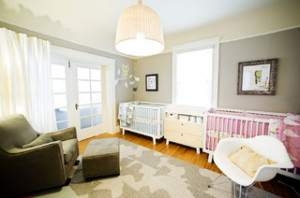A difficult economy and job market have forced many young families to live on a smaller scale. While for some this simply means running a tight household budget, for others it quite literally means living in a smaller space, such as a small house or apartment. It also means that, more often than not, the children may have to share a bedroom. Having two children sharing a single room may seem to be a recipe for disaster, but with careful planning, and by including each child in the process, it is entirely possible to have an organized bedroom that the children can enjoy together that also gives them individual privacy and satisfaction.
Designing for both unity and individuality
When designing and decorating a shared bedroom, parents have to ensure that each child has their own personal space and privacy while also achieving a unified overall look for the room. Creating individual space within a single room can be accomplished by physically dividing the room with a wall or curtain, or by visually dividing the room with colour and pattern.
Begin by dividing the room into sections: two individual areas, where each child has their bed and personal things, as well as a centralized area that they can share.
Creating individual spaces within a single room can be accomplished physically by dividing the room with curtains, custom fitted shutters or even sliding panels. These give the added advantage of adding texture to the room through fabric, as well as creating more wall space for each child to decorate with favourite pictures or posters. Shutters as a divider also add an element of fun, allowing kids to slip little notes back and forth through the mailbox-like slots.
Another way to divide a room is to do it visually with colour. If the children each have a different favourite colour, this makes the job even easier as the walls may simply be painted different colours in each child’s section. Use the favourite colours on two of the walls and unify them with a neutral colour on the other two walls. T he accessories and furniture in the room will also help to anchor the room and create a unified design.
Practical furnishing for style and storage
Multiple beds in even an average size room take up a great deal of space, but a variety of bed options can be explored to allow for personal space while taking up as little space as possible. A bunk bed system can help to save on space, allowing for storage units, shelves or even desk/ study areas to be positioned underneath the beds, freeing up floor space. If possible, separate the bunk beds or stagger them along a single wall to give each child their own place.
Daybeds may be a good choice for a small space, particularly if they have a frame that contains drawers, sometimes called a captain’s bed. Foldaway beds are another option. Murphy-style beds allow the bed to be folded up and out of sight when not in use.
Pull the room together with matching bedspreads, patterned sheets and other custom touches that let each child’s personality shine. Add comfortable chairs and floor cushions for flexible seating in the shared area.



